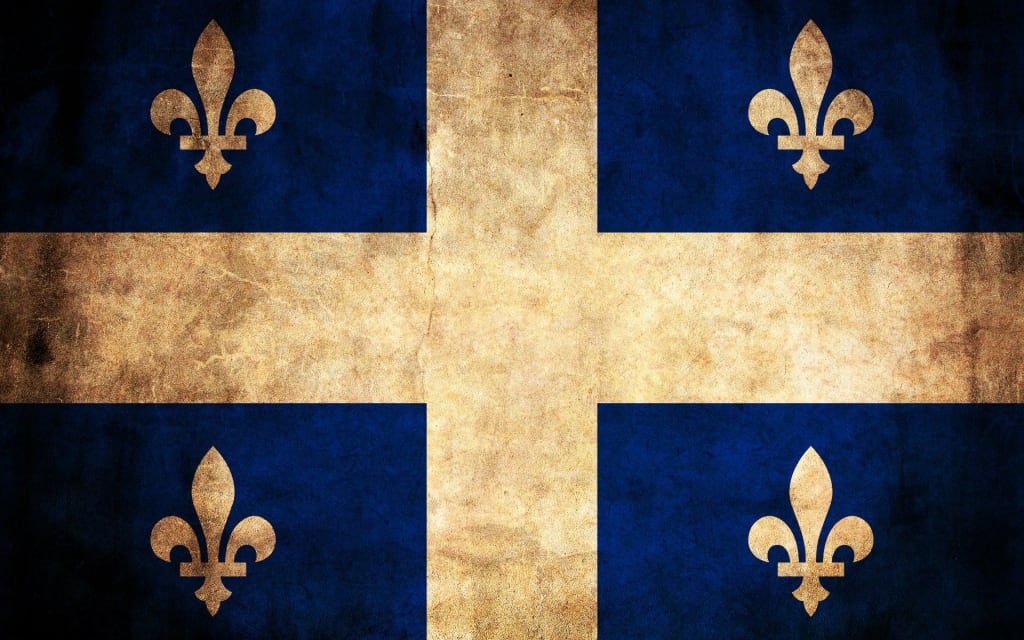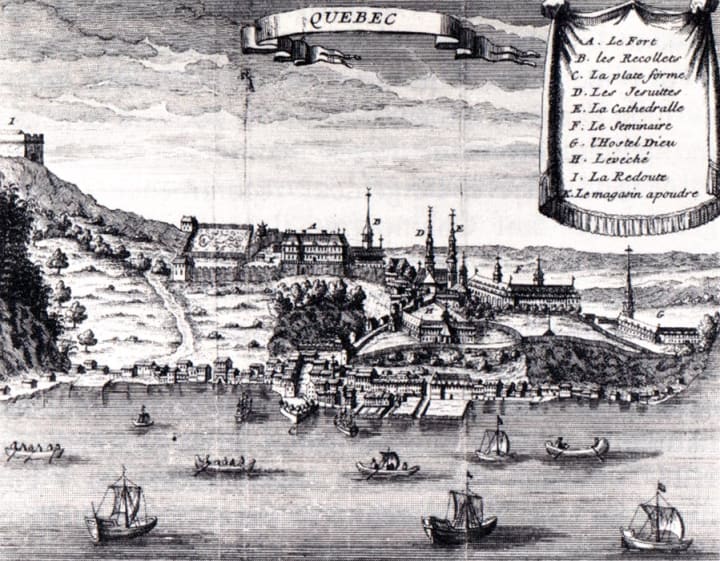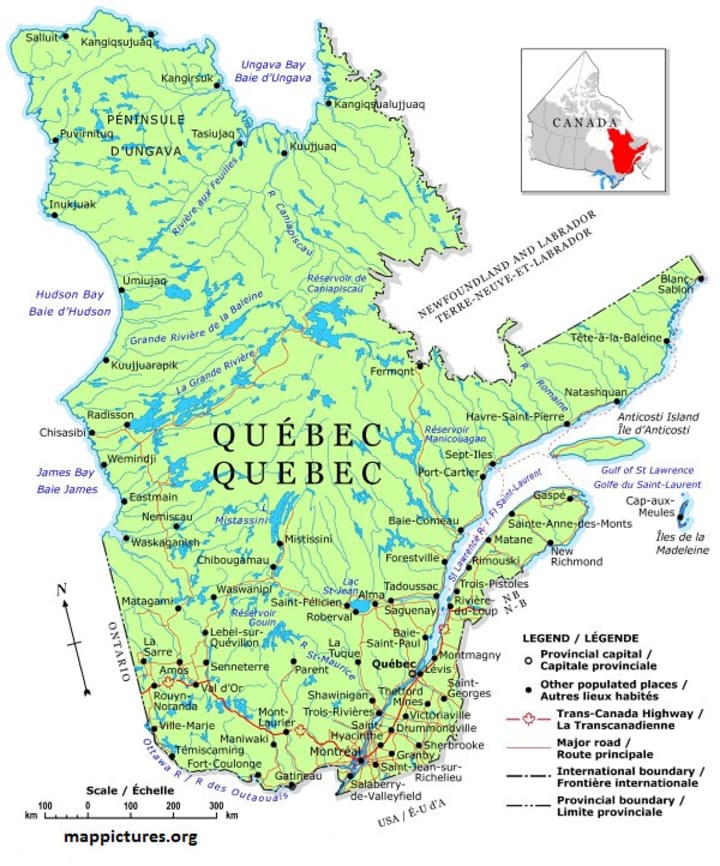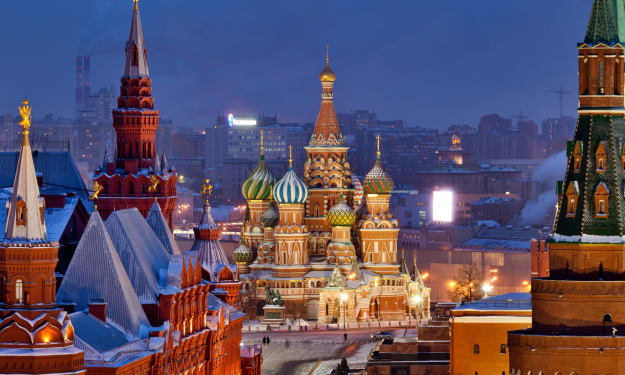
Quebec is the French-speaking province located in the Eastern part of Canada. This province is home to the majority of Canada’s French-speaking residents and is predominantly francophone. The capital of this province is Quebec City (Ville de Québec). This capital is Canada’s oldest city and is home to many structures that date back to the 17th and 18th centuries. The history of Quebec and Quebec City is one of trying to preserve their own culture, language, and to be recognized. Their histories are intertwined. In order to discuss the history of the Quebec, the history of Quebec City must be discussed along with it.

Iroquois
To begin, it is necessary to travel back to the beginning. Before it was called Quebec and before there was a Quebec City, the first significant settlement on the site of today's Quebec City was an Iroquois village of 500 called 'Stadacona.' The Iroquois were semi-nomadic, building longhouses, hunting, fishing, and cultivating crops until the land got tired and they moved on (Lonely Planet). The first European to settle a colony on the land that is now Quebec City was the French explorer Jacques Cartier, who established a settlement in 1534, where modern-day Quebec City is. However, Cartier and his crew couldn’t stand the harsh winter and they all went back to France by 1536. He then returned to the New World in 1541 and tried to make another settlement. Yet again, he failed. He and his crew could not stand the harsh winter, scurvy, and a hostile indigenous population. Cartier and his crew packed their bags and went back to France (Lonely Planet).
Quebec City, the one that still stands today, was founded on July 3rd in 1608 by a French navigator by the name of Samuel de Champlain. Prior to the founding of the city, he arrived at the area of Quebec in June of 1608. Champlain and his crew constructed a fort and Quebec soon became the hub for French fur trading (Biography.com). Then, on July 3rd in 1608, Samuel de Champlain feeling very assured of his decision to choose this spot in North America (to create the settlement known as Quebec City) stated, “I arrived there on the 3rd of July when I searched for a place suitable for our settlement, but I could find none more convenient or better situated than the point of Quebec (The Canadian Encyclopedia)." Which, in turn, planted the fleur-de-lys and marked the beginning of Quebec City. At this time, Quebec City was referred to as Quebec and the province of Quebec did not yet exist.

1600s early Quebec settlement
After the founding of Quebec, the settlers experienced a humble and precarious existence for about 20 years, making money from trading furs. In 1629, that all changed. During this year, Quebec had been sieged and taken over by the British under Sir David Kirke (Encyclopedia of Quebec History). After three years, France regained Quebec and all other territories lost to the British under the Saint-Germain treaty of 1632 (The Canadian Encyclopedia). This event also marked the beginning of many battles the Quebecers would have to fight against the British and even a battle against the revolutionists in America. This also marked the beginning of the battle to preserve French culture within Quebec. In 1759, during the Seven Year’s War, British troops beat the French army and took over Quebec as their own in the Battle of Quebec, solidifying the British supremacy of Canada (History.com). In 1763, the Treaty of Paris gave Canada to the British. The original French settlers of Quebec were not happy under the rule of the British. They had many problems with the English since they, the English, were a foreign culture to them. In 1774, the British rulers implemented the Quebec Act which restored the ancient civil laws of the Quebecers and conceded a greater liberty for the exercise of their religion. This act also drew new borders for Quebec, making it larger in size, to try and appease the Quebecers so they would not join the Americans in opposing the British (Encyclopedia of Quebec History). This was successful and in 1775 when the American forces fought in Quebec, the Americans lost and Quebec remained loyal to the British (Encyclopedia of Quebec History).
After the American invasion, there were great political dissensions between Quebec and English-speaking Canada. In 1791, it was found necessary to add a second constitution. Which allowed for Quebec to be more independent from the English because the French Canadians felt overshadowed by the English and the English settlers felt as though the French Canadians had too much power still. Thus, it split Canada into upper and lower. The English were in the upper section and the French were in the lower section. Many historians credit this act to starting the movement of nationalism amongst the Quebecers (The Canadian Encyclopedia).

Quebec on a map
Later, in 1864, meetings were held in current day Quebec City (at that time it was just Quebec) about the formation of Canada. Quebec was the first province to join this confederation and then it became known as the Province of Quebec and Quebec City was its capital (Encyclopedia of Quebec History). Thus allowing for the people of Quebec to have more autonomy and a lot more freedoms. By 1867, Canada had become a country in the British Empire under the British North America Act, known as the constitution act in the current age. After the formation of Canada, the country and Quebec hadn’t gone through much. It wasn’t until the second industrial revolution that things started to pick up again. The first industrial revolution wasn’t even much of a revolution. It was more of a gradual industrialization. Quebec, traditionally an agricultural society, transitioned into a more urban, industrialized one during the early 20th century (Lonely Planet).

Riots at the Quite Revolution
Then, during the 1960s, the Quiet Revolution occurred in Quebec. During which all aspects of francophone society were scrutinized and overhauled. Intellectuals and extremists alike debated the prospect of independence from Canada, as “Québécois” began to assert their sense of nationhood (Lonely Planet). The goal of this revolution was to keep Quebec French. They wanted to be able to ensure their livelihood within the predominately English-speaking nation. During this time (1968), the Quebec separatist party, called “Parti Quebecoise," was formed. This party didn’t gain power until 1976 and separation didn’t happen. Nonetheless, some aspects of the Quiet Revolution were successful because the Royal Commission on Bilingualism and Biculturalism was put into place. With this in place, Quebec’s language and culture was more protected. This commission led to French education country-wide so that the English speakers could learn French just like how the Quebecers were learning English (The Canadian Encyclopedia). The commission then led to the Official Languages act of 1969. This made French and English the official languages of Canada, giving them equal status in the country. It requires all federal institutions to provide things in French or English upon request (The Canadian Encyclopedia). This act ensured the province of Quebec that their language would not disappear within the province and in the nation.
Finally, in 1976, a small win for Parti Quebecoise and Quebec nationalism occured. They had won 71 out of 110 seats in the provincial national assembly. In the following year, the Assembly decreed French the only official language of government and business in Quebec, and in 1980, a referendum was created for seeking approval for the provincial government to negotiate a new status and relationship with the rest of Canada (Encyclopedia Britannica). Even though this referendum failed the new laws that were put in place helped solidify Quebec’s French identity. After all of the years that the Quebecers had endured British rule, they were finally able to solidify their sovereignty within Canada and Canadian society (The Canadian Encylopedia).
All in all, the province of Quebec and Quebec City has a rich and fascinating history. In the beginning, it was founded to be a fur trading center, then later it became a province and the original settlement was named Quebec City and became the capital of the province. Throughout the years the Quebecers had to fight to keep their culture and identity alive throughout various invasions from the British, Americans and then the final invasion from the British that solidified Quebec as a territory under British rule. Even after all that, the province of Quebec and her people had to make sure to get laws in place to help preserve their distinct identity within Canadian society. The Quebecers were able to maintain their culture and keep their heritage alive.
Work Cited
The Editors of Encyclopædia Britannica. “Parti Québécois.” Encyclopædia Britannica, Encyclopædia Britannica, inc., 20 Oct. 2015, www.britannica.com/topic/Parti-Quebecois.
Planet, Lonely. “Subscribe.” History of Québec City - Lonely Planet Travel Information, www.lonelyplanet.com/canada/quebec-city/history.
Marsh, James H. “Champlain and the Founding of Quebec.” The Canadian Encyclopedia, www.thecanadianencyclopedia.ca/en/article/champlain-and-the-founding-of-quebec-feature/.
History.com Staff. “Battle of Quebec (1759).” History.com, A&E Television Networks, 2009, www.history.com/topics/battle-of-quebec-1759.
“Samuel de Champlain.” Biography.com, A&E Networks Television, 28 Apr. 2017, www.biography.com/people/samuel-de-champlain-9243971.
“Quebec History.” Province of Quebec - History, geography, economy, education and government - Encyclopedia of Quebec History, faculty.marianopolis.edu/c.belanger/quebechistory/encyclopedia/QuebecProvinceof.htm
About the Creator
Kenny C
I am 19 years old and I am majoring in secondary education to become a history teacher. I like history and foreign languages/cultures.






Comments
There are no comments for this story
Be the first to respond and start the conversation.